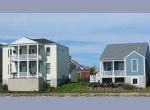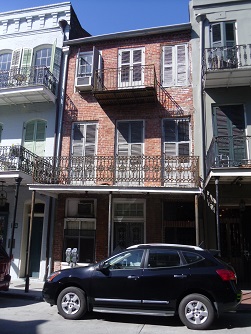Infill Housing Increases Neighborhood Vitality
Last Updated: October 1, 2022
Adding infill housing on vacant lots will make a residential neighborhood feel vibrant again. Advantages of encouraging infill housing include these:
- Empty urban spaces seem to invite people to throw trash on it and to think the worst. Simply filling the space with architecturally appropriate new housing will enhance neighborhood reputation.
- Infill housing can help address a deficit of affordable housing, since utilities and streets already are in place.
- In fully built suburbs, vacant lots subtly imply lack of demand, unless they are well groomed and visually connected to the house next door. You can avoid a negative signal to the housing market about your neighborhood if lots do not stay vacant.
- Infill housing obviously is a positive alternative to the many negative consequences of sprawl.
- Adding homes on vacant lots will improve the demand for retail, services, and transit, making it more likely that these public goods will be available for all.

When urban design is strong, as in this photo from Florida, a missing house is very noticeable. If you go by a vacant lot every day, you're likely to be numb to the sensation. Visitors won't be.
In rural areas infill housing might be described simply as a new house, or fill-in. That language is fine too; we're just trying to give you the terminology to let you understand the jargon of the day.
Infill seems difficult, risky, and expensive to developers and builders because it is less predictable than building a subdivision.
Successful infill projects require careful thought about architecture and urban design principles.
Matching the number of stories of the homes in the area, the general architectural style, the setback from the street, and the materials to some extent are very important to whether the infill housing will be just a new eyesore or whether it will blend in well and bring a new housing choice.
What about situations where there already is an abundance of housing in the region, but a few empty lots looking like missing teeth in a particular block? Then it's even more tricky to entice a developer to build, and to build at a cost that is in line with what the neighborhood will bear.
If it's too expensive, it will sit empty and not be much of an asset.
However, in an overbuilt region such as many in the U.S. right now, infill housing is worthwhile in the older and denser parts of the community. This is especially true closer to the urban core, where long-term viability should be greater.
Incentives for Infill Housing Development
So what incentives can a local government that wants more scattered site development offer? If this is a serious issue for you, you should think about a short property tax abatement, if allowed by your state. Depending on state law, you might even be able to create a tax increment financing district in a neighborhood that needs quite a few units of infill housing. For example, a builder who added five infill units for you within a certain planning district could receive a larger percentage or longer property tax abatement.
Of course we don't advocate for abuse of TIF just to give a developer extra profits, but if the neighborhood really needs a nudge, this might be an option. This will help sell the property, and give the builder the confidence that he or she will sell in a timely fashion.
Neighborhood associations and city governments also can work with developers and small-scale builders to help them understand federal and state incentives, such as enterprise zones, opportunity zones, and state-created programs. Neighborhoods and towns could offer technical assistance to the smaller builders, who are more likely to be interested in building single homes than larger home builders anyway.
Take a hard look at the zoning regulations that pertain to the area where you'd like the scattered fill-in housing.
Is it easy to meet zoning requirements, given the type of housing units that will sell in your city today, or is it tricky? You might need to think about changing a regulation or two if you can't build a viable modern home on the lot.
You may be able to offer improved infrastructure or even utility assistance or rebates of some type.
Maybe you should go in a whole different direction and talk your chamber of commerce into offering a prize for the best infill project.
You might have to be creative in incentives, wonderful publicity for good guys or gals who do the work, marketing assistance, or tax policy. Good old-fashioned one-to-one recruiting visits with builders and developers may work also.
Smaller Builders Are More Likely to Build on Scattered Sites
Unless you have large pockets of the city with many blocks each offering infill opportunities, you will have a hard time finding a "greenfield developer" who wants to build the occasional medium-priced home. A greenfield developer simply means a firm that usually starts with a farm or previously undeveloped land and builds a subdivision or meaningful portion of a subdivision at a time.
You will be better off with the smaller scale home builder who likes to do a few houses a year with a relatively small crew. You will have to work harder to find this builder, as he or she does not have time to look for ads for requests for proposals. But ask real estate agents, building officials, and others for referrals, and then visit those builders personally.
But then, of course, the small builder doesn't have economies of scale working to keep costs lower. So that's what tends to increase prices of infill housing. That is why we recommend putting together a package of 5 to 30 vacant lots where building can and should occur. If your neighborhood is relatively uniform in architectural style, one enterprising architect can put together several variations on the appearance of the same basic house. Look for that sole proprietor architect or a very small firm.
Infill is an important goal where there are several vacant lots in close proximity. Depending on your market, in a medium-sized city those 30 lots in a neighborhood could make a real difference in keeping costs to the eventual buyers affordable. In a smaller town the number would probably be much lower. Experiment with that approach. You can take advantage of existing infrastructure, such as streets and utilities, which in many cases already have been paid for.
Lately we have been thinking about the potential for adding infill housing to address the "missing middle" problem. This term refers to the fact that in many desirable neighborhoods, prices have been rising more rapidly than the city really would like, meaning that the teachers, social workers, and emergency workers cannot afford to live there. In many such neighborhoods there are a few vacant lots, but they are expensive. Yet adding a few housing units helps create more demand for local businesses and keep the sidewalks livelier, so enlightened city leaders want to see more homes built. In this situation, look into the potential of a community land trust to hold land prices down.
Suggested Pages for those Interested in Infill
Join USEFUL COMMUNITY PLUS, which provides you monthly with short features or tips about timely topics for neighborhoods, towns and cities, community organizations, rural environments, and our international friends. Unsubscribe any time. Give it a try.





